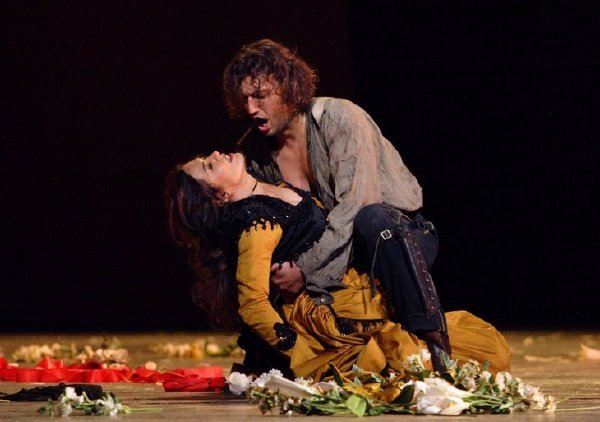|
|
|
|
|
|
|
|
| Opera News, March 2007 |
|
Bizét: Carmen, Royal Opera House, London, December 2006
|
Carmen Royal Opera House
|
|
 It's been twelve years since the Royal Opera
performed Carmen, which is a long time, even given the fact that that period
includes the closure and rebuilding of Covent Garden. It appears to be a
plank of the theater's current artistic policy to reinstate popular
favorites, presumably including Bizet's masterpiece, in sensible,
good-looking productions that will sustain regular revival. The choice of
director for the important assignment of visualizing one of the few operas
whose fame extends well beyond the charmed circles of opera initiates fell
on Francesca Zambello, working with designer Tanya McCallin, lighting
designer Paule Constable and choreographer Arthur Pita. The new Carmen
opened on December 8. It's been twelve years since the Royal Opera
performed Carmen, which is a long time, even given the fact that that period
includes the closure and rebuilding of Covent Garden. It appears to be a
plank of the theater's current artistic policy to reinstate popular
favorites, presumably including Bizet's masterpiece, in sensible,
good-looking productions that will sustain regular revival. The choice of
director for the important assignment of visualizing one of the few operas
whose fame extends well beyond the charmed circles of opera initiates fell
on Francesca Zambello, working with designer Tanya McCallin, lighting
designer Paule Constable and choreographer Arthur Pita. The new Carmen
opened on December 8.
The general look of McCallin's Seville was realistic and idiomatic in terms
of costumes, and again realistic, with just a hint of semi-abstraction, in
terms of the lowering orange walls that formed the adaptable unit set. The
ease of moving these around into different configurations helped the evening
flow briskly (just one interval, following Act II), as did the lithe,
graceful conducting of music director Antonio Pappano, whose way with the
score delivered its passion and psychological richness without sacrificing
its Gallic lucidity.
Zambello's concentration on character and narrative placed what are
undoubtedly "numbers," even in Bizet's original, within a clear-edged
intellectual framework. The dance routines at Lillas Pastia's (the character
was presented here, in a minor deviation from the text, as a woman, by
Caroline Lena Olsson) were executed with vivacity and point. The
participation of some animals — a donkey in Act I, a horse for Escamillo's
entrances in Acts II and IV and somewhere, apparently (though I must have
blinked), a chicken — looked a bit old-fashioned, but it was fun, and the
cast was good enough not to be even momentarily upstaged.
It was led by the Gypsy of Anna Caterina Antonacci, whose sole previous
Covent Garden appearance was as Elcia in a short-lived staging of Rossini's
Mosè in Egitto back in 1994. (She's sung Rossini's Ermione and Handel's
Rodelinda at Glyndebourne more recently.) Antonacci is the real thing.
Though many of her roles are unequivocally soprano parts, Antonacci's voice
matched perfectly with the lower-lying Carmen, her tone emerging free and
easy and avoiding any chest-voice gutturals. She was consistently musical
and elegant. She was also dramatically formidable, flawless in her stage
flamboyance, her intelligence and her sense of control. The Royal Opera
could have found no one better to do the part.
Antonacci was finely matched by the Don José of Jonas Kaufmann, another
artist of significant musicality and intelligence. He's not a vocal bruise
of a corporal — indeed he's a little on the light side — but he deploys his
voice so cannily that one never really notices. Above all, he shaped every
line beautifully, making a great thing, quite properly, out of the flower
song. As an actor, he was expert and considered, charting José's fall from
grace into violence with a careful and revealing attention to dramatic
detail.
Making up the rest of the central quartet were the traditionally macho and
vocally healthy Escamillo of Ildebrando D'Arcangelo, who also had charm and
humor, and the gauche, pigtailed Micaëla of Norah Amsellem, the only French
principal, who made her character's gentle lyricism and good-girl behavior
blossom into an effective foil for Antonacci's raunchier protagonist.
Every one of the smaller roles, too, had something special to offer, with
the young South African baritone Jacques Imbrailo's Moralès, British bass
Matthew Rose's Zuniga and Australian soprano Elena Xanthoudakis's Frasquita
all shining with particular brightness.
|
|
|
|
|
|
|
|
|
|
|
|
|
|
|
|
|
|
|